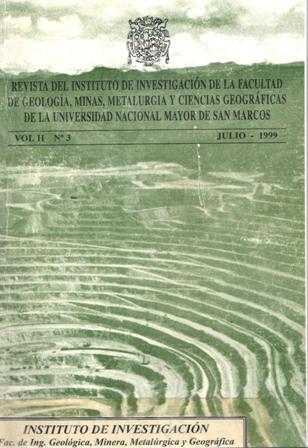El fenómeno de El Niño bajo una concepción geológica
DOI:
https://doi.org/10.15381/iigeo.v2i3.2117Palabras clave:
fenómeno El Niño, El Niño Tectónico, corrientes marinas frías, reacciones termoquímicas, vulcanismos sulfurososResumen
El fenómeno El Niño es un evento natural, frecuente en el cinturón de fuego del Océano Pacífico, caracterizado por una intensa actividad tectónica: volcánica y sísmica que adicionan energía al fondo oceánico y la atmósfera provocando el fenómeno de El Niño tectónico. La Tierra está constituida por geósferas a los estados sólidos, cristalinos, líquidos y gaseosos dispuestos según su densidad. Todas ellas giran hacia el Este a diferentes velocidades. Las geósferas sólidas y cristalinas del núcleo central y la litósfera externa, rotan a mayor velocidad que las geósferas fluidas del interior y del exterior, generando un espacio diferencial creciente (D x) que aumenta de Este a Oeste y gobierna el movimiento de los vientos alisios y las corrientes marinas frías. El instante en que D x=0 habrá una superposición de geósferas a nivel de Sudamérica, con anulación de los vientos alisios y las corrientes marinas frías, generándose El Niño tectónico en dichas latitudes, mientras tanto a 180° de ella se manifestará La Niña. La superposición de las geósferas en otras latitudes del Oceano Pacífico también genera El Niño tectónico, sin embargo, dichos fenómenos son muy débiles, dominados por los efectos opuestos al calentamiento, por cuanto la corteza oceánica o continental en dichas latitudes son más gruesas y poco fracturadas, no permitiendo la fácil salida del magma y la energía al fondo oceánico y la corteza continental, dominando por tanto en dichas estadios La Niña. En el instante de la superposición, se vigoriza el tectonismo con sismos y vulcanismos cargados de azufre que reaccionan con el oxígeno del aire o de los océanos formando SO2 y SO3 que al contacto con el agua se convierten en ácido sulfúrico (H2SO4), estas reacciones termoquímicas provocan el consumo del oxígeno del medio, calentamiento y acidificación del aire y del océano, produciendo la ruptura de la cadena trófica por reducción de nutrientes con la consiguiente muerte y desaparición de especies marinas y terrestres. En caso de vulcanismos subaéreos saturados de cenizas y azufre aumentan la temperatura, la densidad y viscosidad de la atmósfera haciendo que el aire sea más denso y erosivo atacando los tejidos epiteliales de los seres vivientes en contacto con el fluido, provocando infecciones respiratorias (asmáticas, bronquiales) y casos de conjuntivitis entre otros. Durante los fenómenos de El Niño tectónico, los volcanes adicionan al medio diferentes elementos químicos e isótopos como: HCl, F, Br, CO, CO2,N, H, Ca, Ba, Cd, S, H2S, CH4, Mn. etc. que en contacto con el oxígeno y el agua producen reacciones químicas y termoquímicas posteriores, consumiendo el oxígeno del medio. Estos elementos presentes en el medio son asimilados por los diferentes organismos, algas, corales, moluscos, etc. y en los estudios isotópicos efectuadas en dichas especies, gran parte de ellas están presentes Por su lado Dumbar, Wellington, Colgan y Glynn reportan la disminución del contenido de isótopos de O(18) en la estructura de los corales de los Galápagos durante los eventos de El Niño, respaldando lo propuesto en esta tesis. Estas aguas aciduladas y calientes producto de las reacciones térmicas y termoquímicas de vulcanismos sulfurosos submarinos, en su movimiento por las profundidades oceánicas atacan a las colonias de los arrecifes coralinos produciendo su decoloración, debilitamiento, que al cabo de años o décadas producirán la extinción y muerte de dichas especies. El evento ENSO del 1982-1983 mató casi la totalidad de los corales de los Galápagos y de otras latitudes del Océano Pacífico oriental (4).
Descargas
Publicado
Número
Sección
Licencia
Derechos de autor 1999 HONORIO CAMPOBLANCO DÍAZ

Esta obra está bajo una licencia internacional Creative Commons Atribución-NoComercial-CompartirIgual 4.0.
LOS AUTORES RETIENEN SUS DERECHOS:
a. Los autores retienen sus derechos de marca y patente, y tambien sobre cualquier proceso o procedimiento descrito en el artículo.
b. Los autores retienen el derecho de compartir, copiar, distribuir, ejecutar y comunicar públicamente el articulo publicado en la Rev. Inst. investig. Fac. minas metal cienc. geogr. (por ejemplo, colocarlo en un repositorio institucional o publicarlo en un libro), con un reconocimiento de su publicación inicial en la Rev. Inst. investig. Fac. minas metal cienc. geogr.
c. Los autores retienen el derecho a hacer una posterior publicación de su trabajo, de utilizar el artículo o cualquier parte de aquel (por ejemplo: una compilación de sus trabajos, notas para conferencias, tesis, o para un libro), siempre que indiquen la fuente de publicación (autores del trabajo, revista, volumen, numero y fecha).






